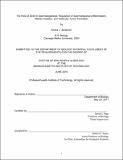The Role of Stra8 in spermatogenesis : regulation of spermatogonial differentiation, meiotic initiation, and testicular tumor formation
Author(s)
Anderson, Ericka L. (Ericka Lynne)
DownloadFull printable version (142.9Mb)
Other Contributors
Massachusetts Institute of Technology. Dept. of Biology.
Advisor
David C. Page.
Terms of use
Metadata
Show full item recordAbstract
Spermatogenesis is a highly regulated, cyclical process where sperm are constantly produced. Previous work characterizing male rodents maintained on a Vitamin A Deficient diet has demonstrated that retinoic acid (RA) governs two transitions during mammalian spermatogenesis. These germ cell transitions include the transition from undifferentiated spermatogonia to differentiating spermatogonia, which continue to proliferate mitotically, and the transition from mitosis to meiosis. This work led to questions about the mechanisms through which RA governs these transitions. Here I will present my findings demonstrating that Stra8, previously demonstrated to be a RA-induced gene, is a target gene of RA in both the transition from undifferentiated spermatogonia to differentiating spermatogonia and the transition from mitosis to meiosis. I conclude that RA inducing Stra8 is the mechanism that regulates these developmental transitions. The architecture of germ cell development in the rodent testis is such that these two RA-governed transitions occur in immediate physical proximity, suggesting the possibility that the RA inducing Stra8 mechanism could regulate both transitions simultaneously. I conclude that this mechanism could play a part in the regulation of the seminiferous cycle during spermatogenesis. In the appendices I will also present my findings that demonstrate Stra8 functions in testicular germ cell tumors. I conclude that Stra8 function in the transition from undifferentiated spermatogonia to differentiating spermatogonia acts as a tumor suppressor for seminoma tumors. In contrast, I find that Stra8 is required for testicular teratomas to form, indicating a role for Stra8 in the formation of these tumors.
Description
Thesis (Ph. D.)--Massachusetts Institute of Technology, Dept. of Biology, 2011. This electronic version was submitted by the student author. The certified thesis is available in the Institute Archives and Special Collections. Cataloged from student submitted PDF version of thesis. Includes bibliographical references (p. 124-129).
Date issued
2011Department
Massachusetts Institute of Technology. Department of BiologyPublisher
Massachusetts Institute of Technology
Keywords
Biology.